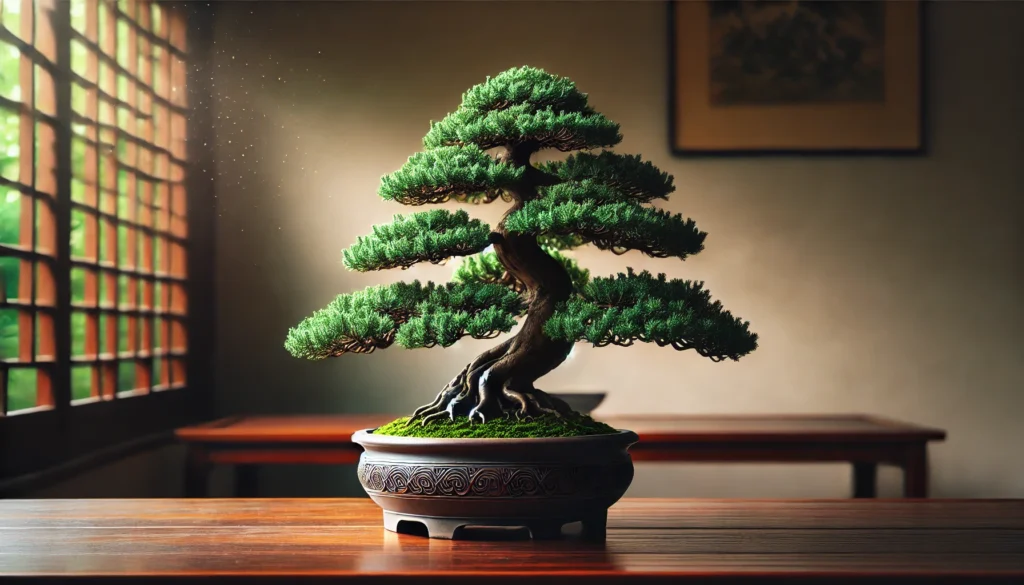
Juniper Bonsai Trees: The Ultimate Guide to Growing, Styling, and Caring for Your Bonsai
Are you captivated by the art of bonsai and dreaming of growing your own juniper bonsai trees? 
In this article, we’ll walk you through everything you need to know about growing, styling, and caring for your juniper bonsai trees. From selecting the right tree to pruning techniques and maintaining a healthy, thriving bonsai, you’ll learn practical, step-by-step advice that ensures success. Ready to cultivate a piece of nature in your home? Let’s dive in and get your juniper bonsai journey started!
Table of Contents
ToggleWhat Are Juniper Bonsai Trees?
Juniper bonsai trees are miniature versions of the classic juniper tree, cultivated through specialized techniques to create beautiful, small-scale replicas. Known for their rugged beauty and resilience, these trees make a stunning addition to any bonsai collection or garden.
The Juniper Bonsai is one of the most popular choices among bonsai enthusiasts, especially for beginners. They are not only easy to care for but also offer a wonderful opportunity for creative styling. These trees feature delicate needle-like leaves and a distinctive twisting trunk, making them visually striking in both traditional and modern bonsai designs.
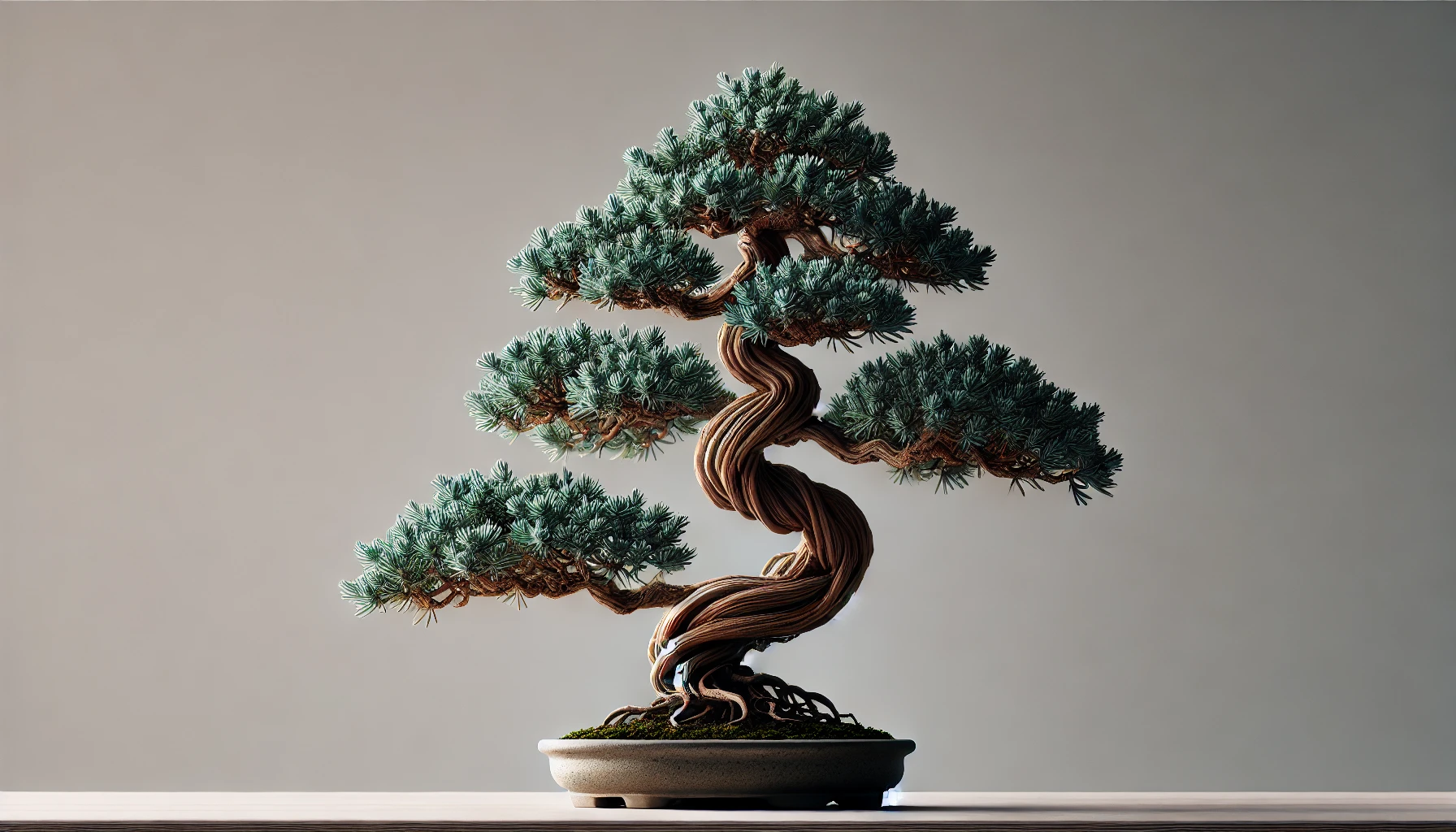
Why Choose Juniper Bonsai Trees?
Juniper bonsai trees are a fantastic choice for both beginners and seasoned gardeners alike. With their unique charm and low-maintenance nature, they bring beauty and tranquility to any space. Here’s why you should consider adding a juniper bonsai tree to your collection:
- Hardy and Resilient
Juniper bonsai trees are known for their toughness. Whether you’re growing them indoors or outdoors, they adapt well to different climates and conditions. Their ability to thrive with minimal care makes them perfect for people with busy lifestyles. - Stunning Visual Appeal
The lush green foliage and graceful branches of juniper bonsai trees create a stunning visual centerpiece. Their twisted trunks and elegant shape make them a perfect addition to any home or garden, adding a touch of serenity and nature. - Easy to Care For
Unlike some other bonsai species, junipers are relatively easy to care for. They don’t require constant pruning and can tolerate dry soil. With just a little sunlight, occasional watering, and basic pruning, your juniper bonsai will thrive and flourish. - Long Lifespan
With proper care, juniper bonsai trees can live for many years, often growing into a beautiful, intricate masterpiece. Their longevity makes them a rewarding choice for any bonsai enthusiast, offering years of enjoyment. - Air-Purifying Benefits
Like many plants, junipers help purify the air by absorbing carbon dioxide and releasing oxygen. This makes them a great addition to your indoor spaces, promoting a healthier and more peaceful environment. - Symbol of Resilience
In various cultures, junipers symbolize strength, protection, and resilience. Having one in your home or garden can inspire positivity and determination, making it a perfect plant for boosting your well-being.
In conclusion, juniper bonsai trees are a perfect blend of beauty, simplicity, and low-maintenance care. Whether you’re a seasoned gardener or just getting started, they are sure to enhance your environment and bring lasting joy.
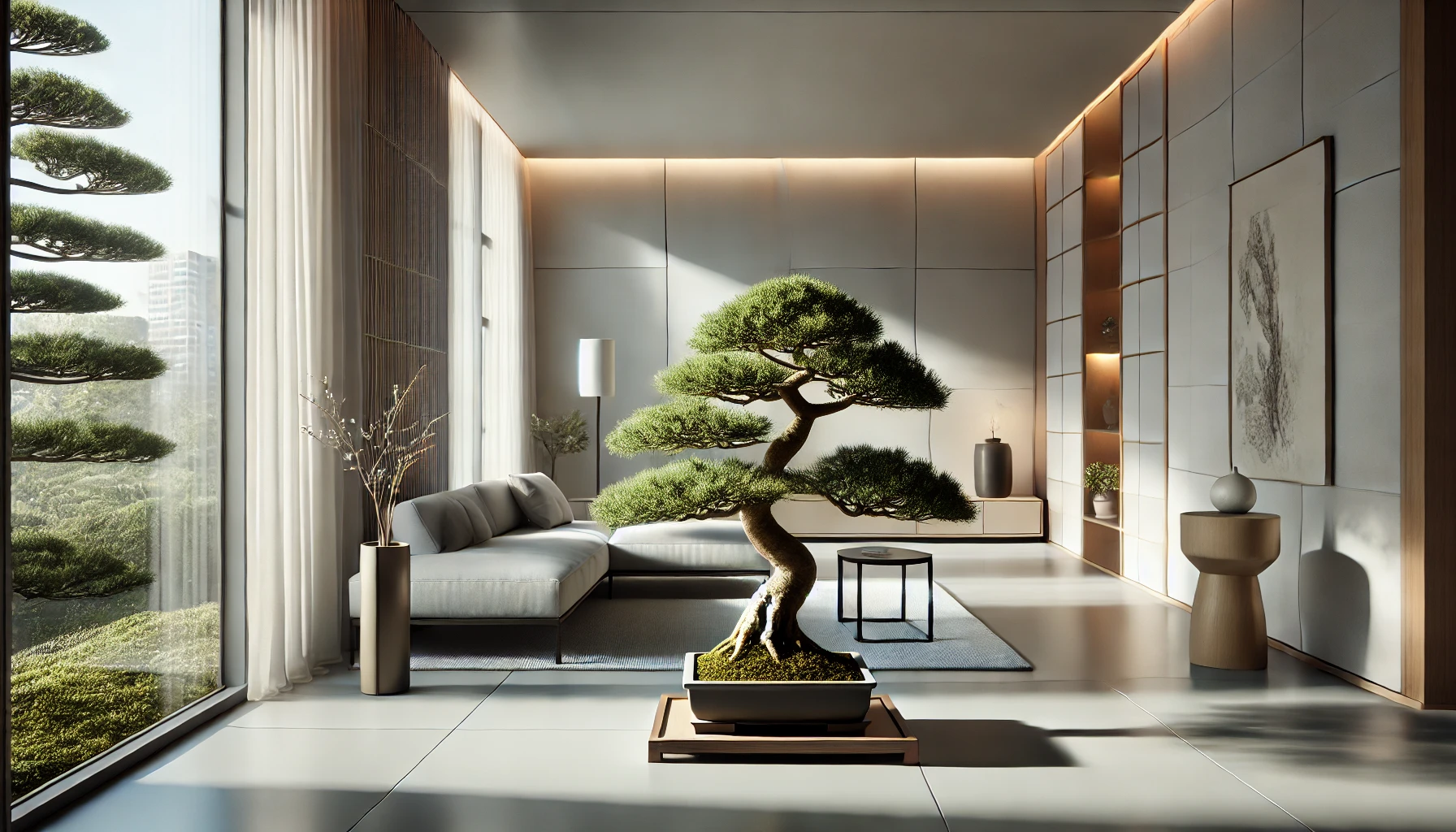
How to Choose the Right Juniper Bonsai Tree for You 
Selecting the perfect juniper bonsai tree is an exciting process, but it’s important to make a thoughtful choice based on your needs and environment. Here’s a simple guide to help you pick the best juniper bonsai for your space and lifestyle.
1. Consider Your Climate 

Junipers thrive in various climates, but it’s essential to pick one suited to your environment. If you live in a colder region, opt for cold-hardy junipers like the Juniperus communis. If you’re in a warmer area, look for varieties like the Japanese Black Pine or the Shimpaku Juniper. Always check the hardiness zone of the tree before purchasing to ensure it can withstand the temperatures in your area.
2. Assess Your Experience Level 
For beginners, choosing a more forgiving variety like the Juniperus chinensis (Chinese juniper) is a smart choice. This tree is relatively easy to maintain and can tolerate beginner mistakes. More experienced bonsai enthusiasts might enjoy working with varieties that require precise care, such as the Shimpaku or Blue Star Juniper. These offer a bit of a challenge but reward with stunning results.
3. Size Matters 
Bonsai trees come in various sizes, so think about the space you have available. If you’re working with a small space or want a bonsai that’s easy to move around, a smaller tree like the Juniperus procumbens ‘Nana’ is a great option. For larger, more dramatic trees, the Juniperus sabina or the Shimpaku might be better, but remember these will need more space to grow and develop.
4. Growth Style & Aesthetics 
Junipers offer various growth forms, from cascading styles to upright, sweeping forms. Think about the aesthetic you’re aiming for. If you prefer a classic look, go for an upright tree. If you’re after something more flowing and natural, consider a cascading variety. Don’t forget to look at the foliage—junipers have needle-like leaves that can range from green to bluish hues, so choose one that matches your preferred color palette for your bonsai collection.
5. Maintenance Needs 
Different junipers have varying maintenance requirements. Some may need regular pruning to maintain their shape, while others are more low-maintenance. If you’re a busy person or new to bonsai care, opt for a variety that’s less demanding, like the Chinese Juniper, which can grow well with minimal attention. If you have the time and patience, consider the more intricate varieties that require detailed care for shaping and styling.
6. Availability & Price 
Juniper bonsai trees come in a wide price range depending on size, age, and variety. Younger trees will cost less but may take more time and effort to shape, while older, more mature trees can be more expensive. Ensure you’re comfortable with the price based on how much time you’re willing to invest in care and training.
By considering these key factors, you’ll be able to select a juniper bonsai that fits your lifestyle, space, and aesthetic preferences. Happy planting!
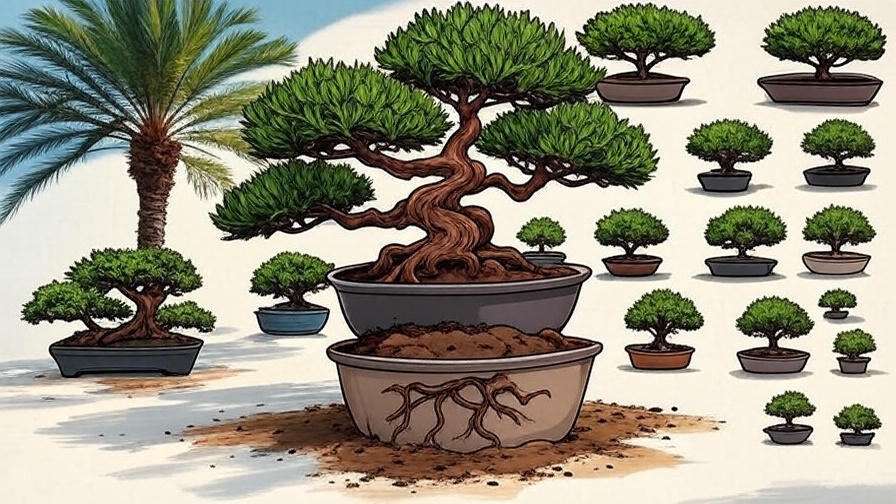
Planting Juniper Bonsai Trees 
Planting juniper bonsai trees can be a rewarding and enjoyable experience, especially for beginners. These resilient and low-maintenance trees are perfect for anyone looking to start their bonsai journey. Here’s a step-by-step guide to help you plant your juniper bonsai with ease:
1. Choose the Right Juniper Variety 
There are several varieties of juniper bonsai, each with its own characteristics. The most popular varieties for bonsai are Juniperus chinensis, Juniperus procumbens, and Juniperus sabina. When choosing, consider the tree’s growth habits and size. Juniperus procumbens is especially popular for its ability to adapt well to bonsai pruning techniques.
2. Select the Ideal Pot 
Your juniper bonsai needs a well-draining pot to prevent water from stagnating around the roots. Opt for a pot with drainage holes to ensure proper airflow and root health. Ceramic or plastic pots are commonly used, with ceramic offering better temperature regulation.
3. Prepare the Soil 
Juniper bonsai trees thrive in well-draining soil. Use a bonsai-specific soil mix or create your own with a blend of akadama, lava rock, and pumice. This mix ensures proper drainage and promotes root health, which is key to the tree’s growth.
4. Position Your Juniper Tree 
Before planting, gently remove the juniper tree from its original container. Carefully untangle the roots, cutting away any that are damaged or too long. Position the tree in the new pot, ensuring it sits upright and centered. Fill the pot with the soil mix, gently pressing down to remove air pockets.
5. Watering After Planting 
Once the juniper bonsai is planted, give it a thorough watering to settle the soil. Make sure the water drains freely from the bottom of the pot. Avoid overwatering, as junipers are sensitive to root rot. Water only when the soil feels slightly dry to the touch.
6. Provide Proper Lighting 
Juniper bonsai trees require plenty of sunlight to thrive. Place your bonsai in a location where it can receive at least 4–6 hours of direct sunlight daily. If you’re growing your juniper indoors, ensure it’s placed near a south-facing window.
7. Be Patient and Observe Growth 
After planting, be patient and observe your juniper bonsai. The tree will gradually adjust to its new environment, and you’ll notice new growth in a few weeks. Keep an eye on its health, adjusting care as needed.
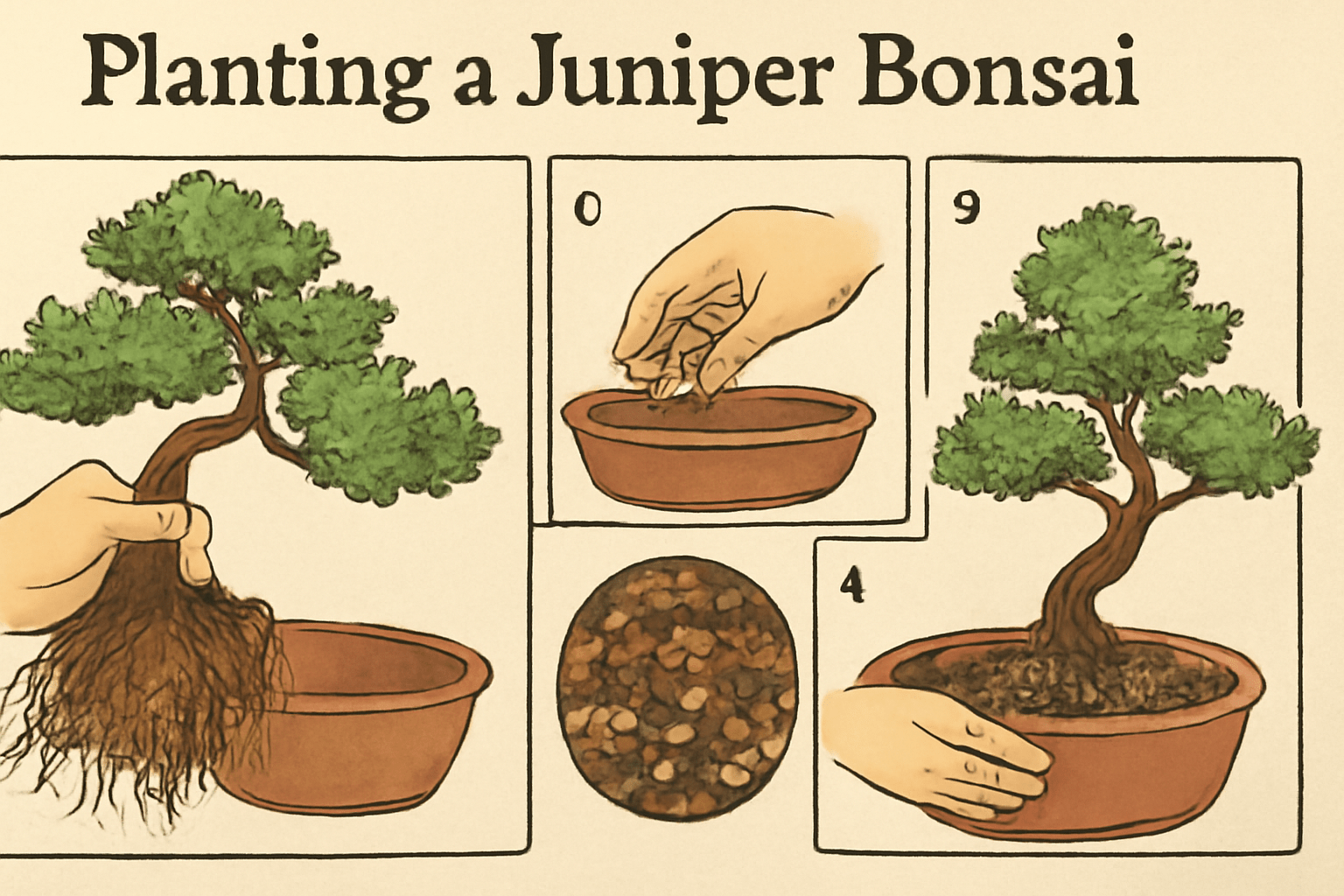
Watering and Moisture Needs 
Juniper trees, while hardy and drought-tolerant, still require the right amount of water to grow healthy and strong. Understanding their watering and moisture needs is crucial to ensure their success.
1. Young Trees Need Constant Watering
When your juniper trees are newly planted, they will need consistent watering to establish a strong root system. Water deeply once or twice a week, especially during dry spells. 
2. Established Trees Are More Drought-Tolerant
Once your juniper tree matures, its roots will grow deeper, allowing it to withstand longer periods without water. However, it’s still important to water during extended dry spells. A good rule of thumb is to water once a month during hot, dry months.
3. Avoid Overwatering
While junipers are drought-tolerant, they don’t thrive in soggy conditions. Overwatering can lead to root rot and other problems. Make sure the soil drains well, and always check if the soil feels dry a few inches down before watering again.
4. Soil Moisture
Junipers prefer well-draining, slightly acidic soil. If you’re in an area with heavy, clay-like soil, consider adding organic matter like compost to improve drainage. This helps prevent water from pooling around the roots and ensures the moisture level stays just right.
5. Mulching for Moisture Retention
Adding a layer of mulch around the base of your juniper tree helps retain moisture and regulate the temperature of the soil. This is especially beneficial during hot summers. Just ensure that the mulch is not piled up directly against the trunk, as this can cause moisture-related issues.
By understanding these simple watering guidelines, you can provide the right balance of moisture to your juniper trees, helping them thrive in various environmental conditions. Stay consistent, but be mindful not to overdo it!
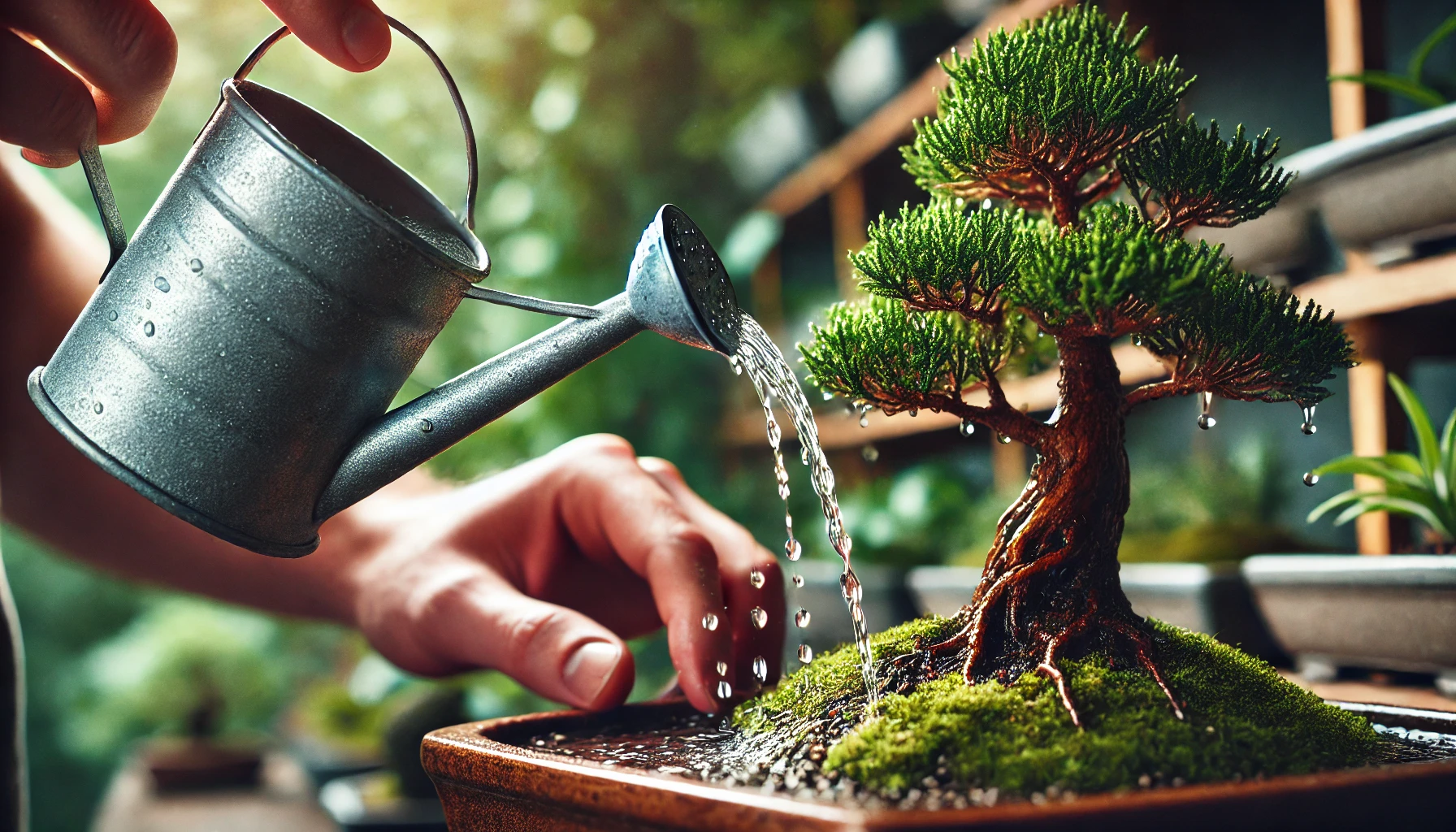
Styling and Pruning Juniper Bonsai Trees 

Styling and pruning are essential parts of growing a beautiful and healthy juniper bonsai tree. With the right techniques, you can shape your tree into a stunning work of art while keeping it strong and thriving.
1. Understand the Basics of Styling 
Before you begin, it’s important to understand that bonsai styling is about enhancing the natural beauty of your tree. Juniper bonsais are incredibly versatile and can be styled in many ways, from the classic formal upright to the cascading style. Choose a style that complements the tree’s natural growth pattern.
2. Pruning Techniques 
Pruning is a vital process to maintain your juniper bonsai’s health and appearance. Regular pruning helps control the size and shape of the tree while encouraging new growth. Here’s how to get started:
- Pinching: Pinching the soft, new growth will help your juniper tree develop a fuller shape. This is particularly useful for keeping the foliage dense and well-rounded. Use your fingers to gently pinch the tips of the branches, removing only the soft growth.
- Trimming: Trim back older, woody branches to maintain the tree’s overall structure. Always use sharp bonsai pruning shears to make clean cuts. Be careful not to remove too much, as this can harm the tree.
- Selective Pruning: Remove any dead or unhealthy branches as soon as you notice them. This will improve airflow and sunlight exposure, promoting healthy growth.
3. Wiring for Shaping 
Wiring is a common technique for shaping your juniper bonsai tree. Use copper or aluminum wire to gently bend and reposition branches into your desired shape. Be cautious not to wire too tightly, as this can damage the bark. Regularly check the wire to ensure it doesn’t dig into the tree as it grows.
4. When to Prune 
The best time to prune your juniper bonsai is during the growing season, typically in spring and early summer. Avoid heavy pruning in the winter, as the tree is in a dormant state and more vulnerable to stress. Always prune when the tree is actively growing to encourage quicker healing.
5. Maintaining Balance 
As you style and prune your juniper bonsai, keep in mind that balance is key. Ensure the tree’s overall shape is symmetrical, with no overly dominant branches. A well-balanced tree looks more natural and pleasing to the eye.
By following these styling and pruning techniques, you’ll be able to maintain a healthy and attractive juniper bonsai tree. Regular attention and care will keep your bonsai looking beautiful for years to come!
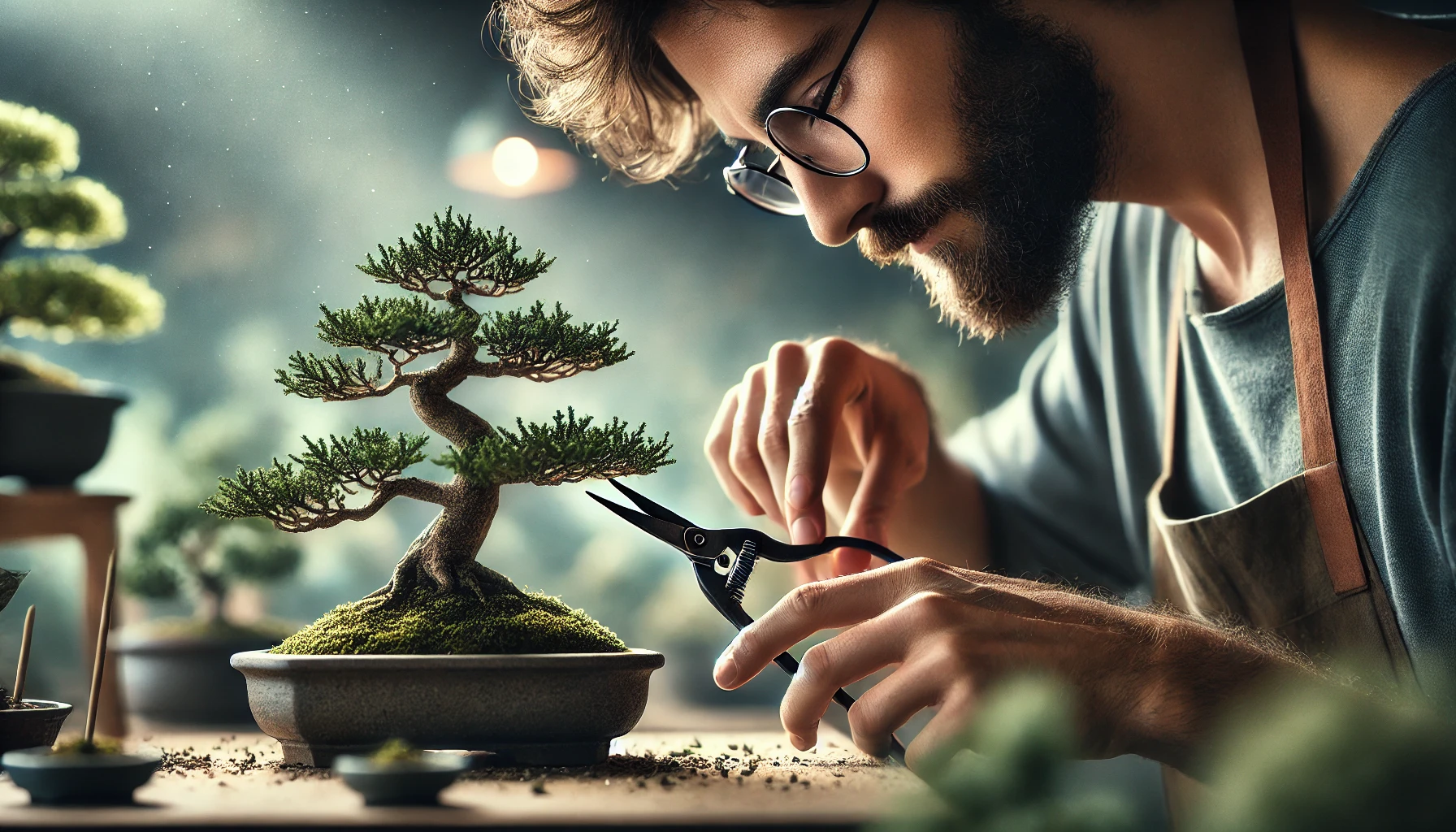
Common Pests and Diseases to Watch For 
When growing juniper trees, it’s essential to be aware of potential pests and diseases that can threaten their health. While these trees are generally hardy, they can still fall victim to a few common problems. Let’s take a look at some of the most frequent culprits and how to protect your junipers from them.
1. Juniper Spider Mites 
Spider mites are tiny pests that thrive in dry, dusty conditions. They suck the sap from your juniper’s needles, causing yellowing and browning. If you notice tiny webs or a speckled appearance on your tree, it’s time to act. Regularly spray your juniper with a strong stream of water to dislodge these pests. If the infestation persists, consider using an insecticidal soap or miticide.
2. Cedar-Apple Rust 

Cedar-apple rust is a fungal disease that affects both junipers and apple trees. It appears as bright orange or yellow spots on the needles, and over time, can cause premature needle drop. To prevent this, avoid planting junipers near apple or other susceptible trees. Pruning away infected areas and applying a fungicide can help control the spread of the disease.
3. Scale Insects 
Scale insects appear as small, round, and hard bumps on the branches or needles. These pests feed by piercing the plant and extracting sap, leading to weakened growth, yellowing, and dieback. If you spot scales, remove them manually or use horticultural oil to suffocate them. Be sure to treat your tree during its dormant season for the best results.
4. Root Rot 
Root rot is often caused by excessive moisture and poor drainage. The roots become waterlogged and are unable to absorb nutrients properly, which weakens the tree. Symptoms include wilting, yellowing needles, and stunted growth. To prevent root rot, make sure your soil drains well, and avoid overwatering your juniper. If you suspect root rot, remove the affected roots and replant in well-draining soil.
5. Powdery Mildew 
Powdery mildew is a fungal disease that creates a white, powdery coating on the leaves and stems. It thrives in humid environments and can stunt growth if left unchecked. To treat powdery mildew, remove infected parts of the tree, and apply a fungicide that targets this specific fungus. Ensuring proper air circulation around your juniper will also help prevent future outbreaks.
By keeping an eye out for these pests and diseases and taking proactive steps, you can help your juniper tree stay healthy and thriving for years to come!
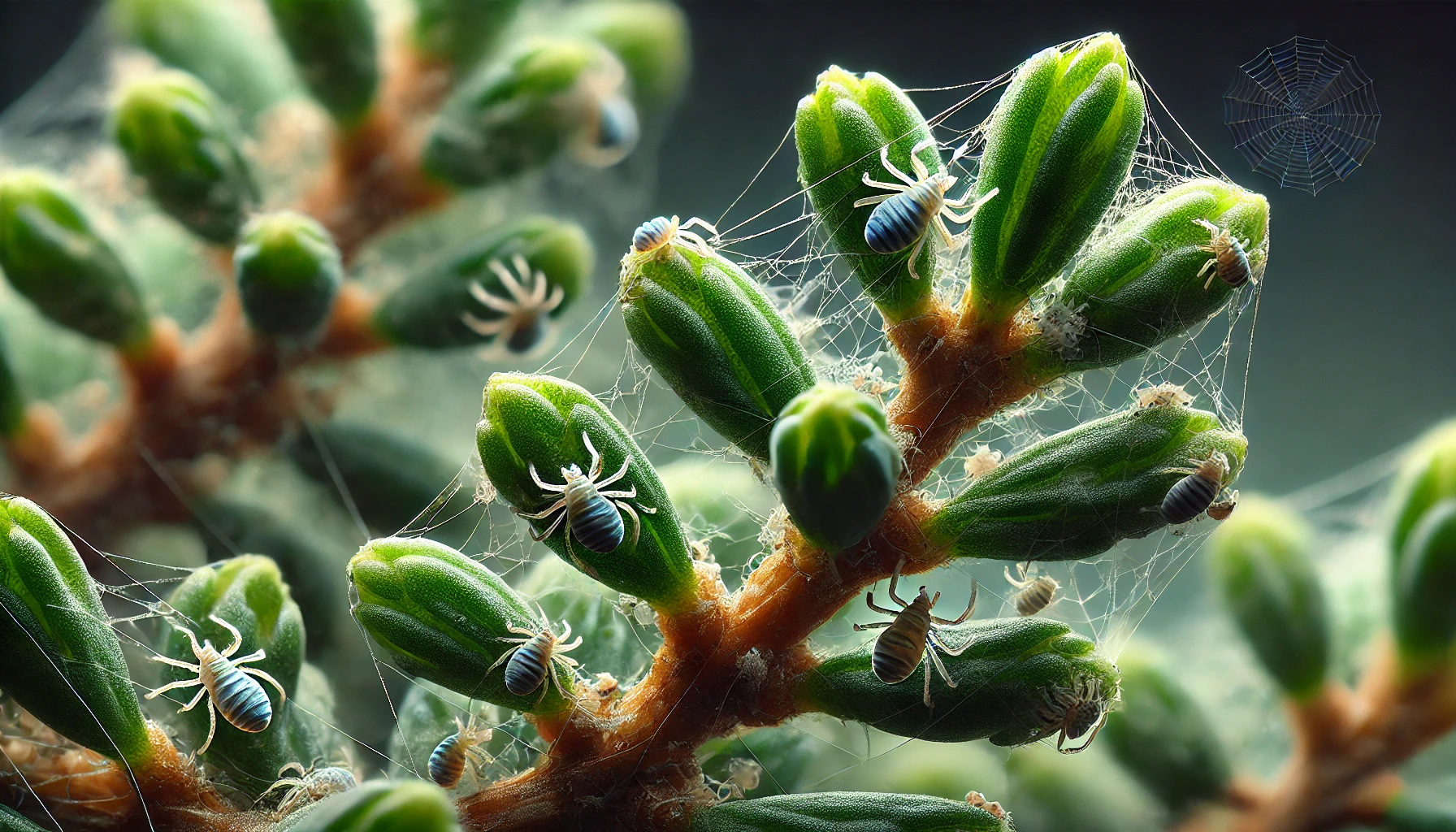
Seasonal Care for Juniper Bonsai Trees 
Taking care of your Juniper bonsai trees throughout the seasons is essential to ensure healthy growth and longevity. While junipers are hardy, they require specific care depending on the time of year. Let’s break it down season by season to help you maintain a thriving tree year-round.
Spring 
Spring is the season of renewal for your juniper bonsai. As the weather warms, your tree will begin to grow more vigorously. Here’s how to help it thrive:
- Pruning: Trim back any dead or unwanted growth to encourage new branches and keep the shape of the bonsai neat. Avoid over-pruning, as junipers need enough foliage to grow properly.
- Repotting: If your juniper has outgrown its pot, spring is the best time for repotting. Choose a slightly larger pot and replace old soil with a fresh, well-draining mix.
- Watering: Water your bonsai when the soil feels dry to the touch. Make sure the water drains well, as junipers don’t like to sit in stagnant water.
Summer 
During the summer months, your juniper bonsai will require more attention as the heat increases:
- Sun Exposure: Junipers love the sun, but in intense heat, it’s best to provide them with some afternoon shade to prevent leaf burn. Ensure they receive at least 4-6 hours of sunlight each day.
- Watering: Hot weather dries out the soil quickly, so water more frequently, but ensure proper drainage. Never let the tree dry out completely.
- Fertilizing: Feed your bonsai with a balanced, water-soluble fertilizer every 4-6 weeks to support its growing needs.
Autumn 
As the weather cools down, your juniper bonsai enters a more dormant phase:
- Pruning: This is the time to do any light pruning to shape the tree. Remove any dead branches and trim back excessive growth.
- Watering: Reduce watering as the temperatures drop, but still check the soil regularly. Junipers don’t require as much water during the cooler months.
- Protection: If you live in a colder area, start moving your bonsai to a sheltered spot to protect it from early frosts.
Winter 
Winter is a time for rest, but your juniper bonsai still needs some care:
- Temperature: Keep your juniper bonsai in a cool area with temperatures between 40°F and 50°F (4°C to 10°C) during the winter. Avoid placing it near heat sources like radiators.
- Watering: Water sparingly, just enough to keep the roots from drying out completely. Be cautious not to overwater, as cold soil can lead to root rot.
- Humidity: If you’re growing your bonsai indoors, increase humidity by placing a shallow tray of water near the tree or using a humidifier.
By following these seasonal care tips, your juniper bonsai will thrive throughout the year, showcasing its beautiful foliage and unique structure. Remember, patience is key to growing a strong, healthy bonsai!
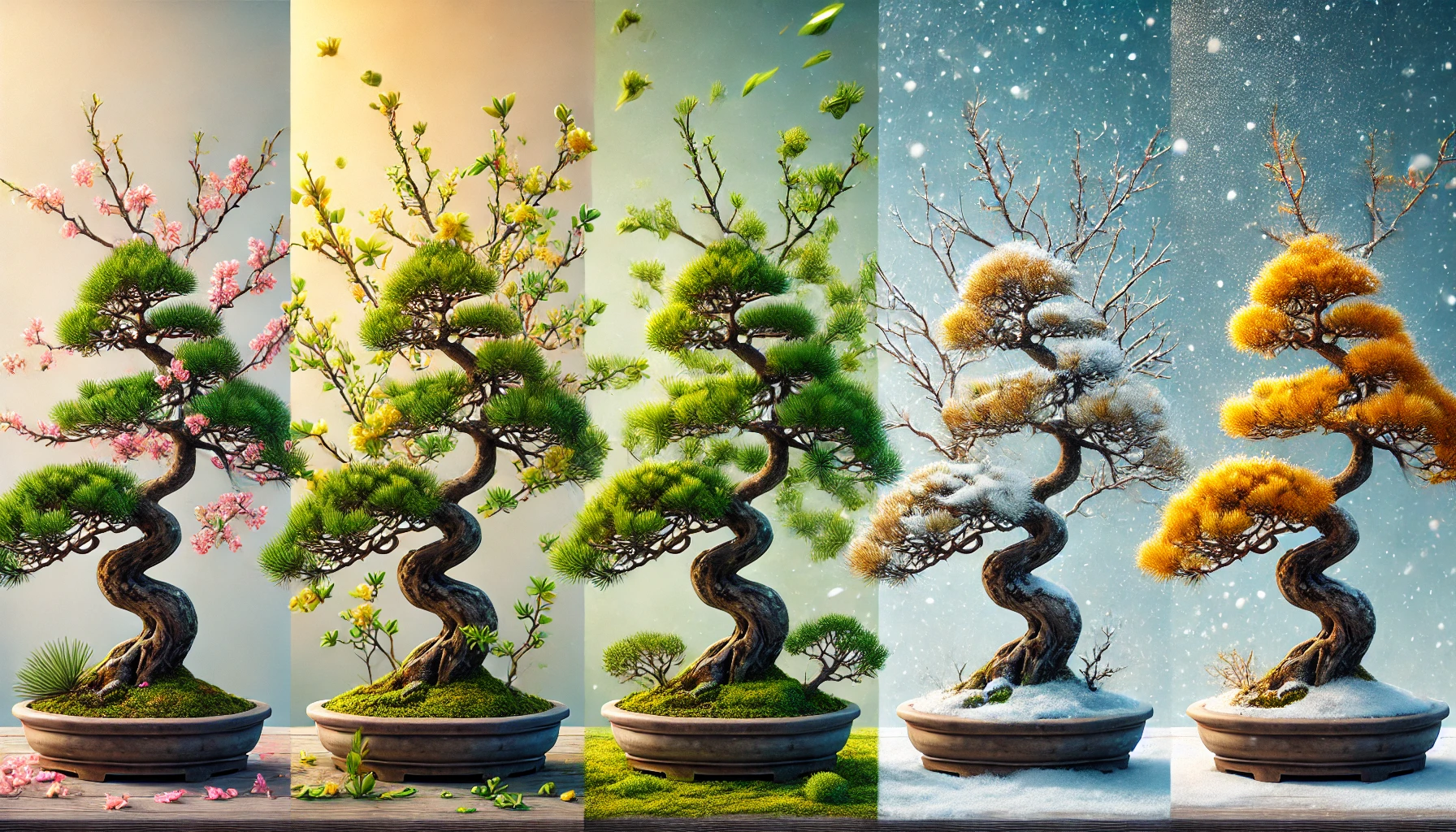
Troubleshooting Common Juniper Bonsai Problems
Caring for a Juniper Bonsai can be incredibly rewarding, but sometimes, problems arise. Here are some common issues and practical solutions to help keep your tree healthy and thriving.
1. Yellowing or Browning Needles
Yellowing or browning needles are a common concern for Juniper Bonsai owners. This issue is usually caused by one of the following:
- Overwatering: Ensure your bonsai has proper drainage. Water only when the top layer of soil feels dry. Avoid letting the tree sit in water.
- Underwatering: If the soil feels too dry, water the tree thoroughly, but don’t let it sit in water.
- Poor Light: Junipers need lots of bright, indirect sunlight. If yours is in a low-light area, move it to a sunnier spot or consider supplemental grow lights.
2. Wilting or Drooping Leaves
If your Juniper’s leaves start wilting, it could be a sign of stress:
- Improper Watering: Both underwatering and overwatering can lead to wilting. Make sure the soil is evenly moist but never waterlogged. A good rule of thumb is to check the soil’s moisture regularly.
- Pests: Small pests like spider mites can cause wilting. Check the underside of the leaves for tiny webs and treat the tree with insecticidal soap if needed.
3. Root Rot
Root rot is often caused by excessive moisture. Signs include a strong, unpleasant smell and soft, blackened roots.
- Fix: Remove the affected roots with sterilized scissors, and ensure the soil drains well. Allow the bonsai to dry out slightly between waterings, and avoid keeping the roots too wet. Consider repotting your Juniper in fresh soil if the damage is severe.
4. Pale or Stunted Growth
If your Juniper is not growing well or appears pale, it may be lacking essential nutrients.
- Nutrient Deficiency: Feed your bonsai with a balanced, water-soluble fertilizer every 4-6 weeks during the growing season (spring to summer). This will help it thrive and promote healthy growth.
- Soil Quality: Check if the soil is compacted or depleted of nutrients. Repotting in a fresh, well-draining bonsai mix may be necessary for better root health.
5. Bonsai Losing Shape
Juniper Bonsai need regular pruning to maintain their shape. If your tree is losing its form or growing unevenly:
- Prune Regularly: Trim new growth back by about a third, and shape the branches with wire to help them grow in the desired direction. Be sure to do this during the active growing season for the best results.
6. Pest Infestations
Juniper Bonsai are susceptible to a variety of pests, including aphids, spider mites, and scale insects.
- Prevention and Treatment: Regularly inspect your tree for pests. If you spot any, use an organic insecticidal soap or neem oil to treat the affected areas. Additionally, keep your bonsai in a clean environment to reduce the likelihood of pest issues.
By staying vigilant and addressing these common problems early, you’ll be able to enjoy a healthy and thriving Juniper Bonsai for years to come. Remember, bonsai care is a journey, and with a little patience, your tree will flourish!
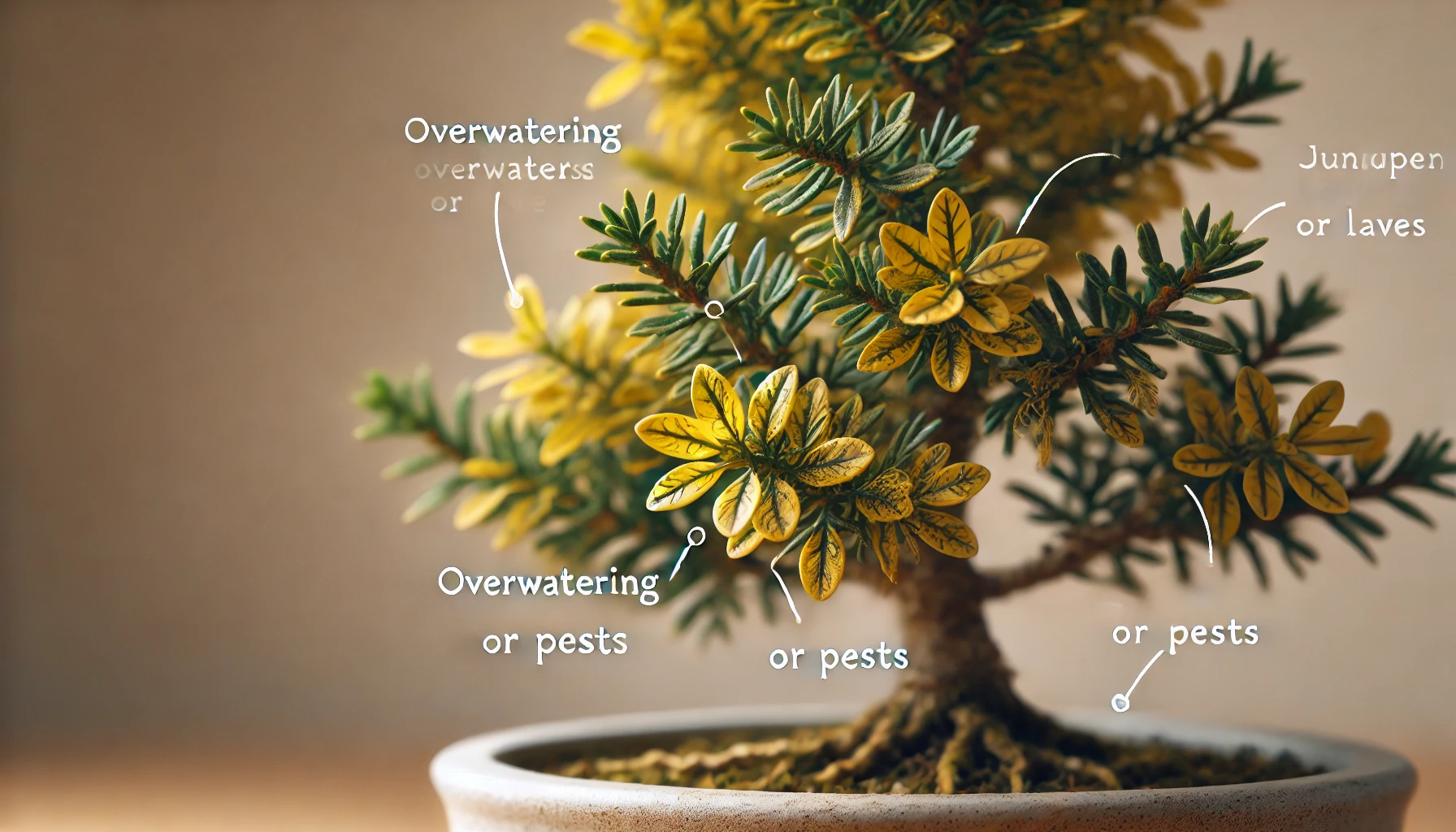
Conclusion 
Growing and caring for juniper bonsai trees is a fulfilling and rewarding experience. With their unique beauty and resilience, these trees make an excellent choice for bonsai enthusiasts, whether you’re just starting out or already have some experience. From selecting the right tree and planting it in well-draining soil to mastering pruning and styling techniques, every step of the journey offers opportunities for learning and creativity.
Remember, patience is key—bonsai trees grow slowly, but with consistent care, your juniper bonsai will thrive. Be mindful of watering, sunlight, and seasonal changes, and always watch out for pests to keep your tree healthy. Whether indoors or outdoors, your juniper bonsai will bring joy and beauty to your space for years to come.
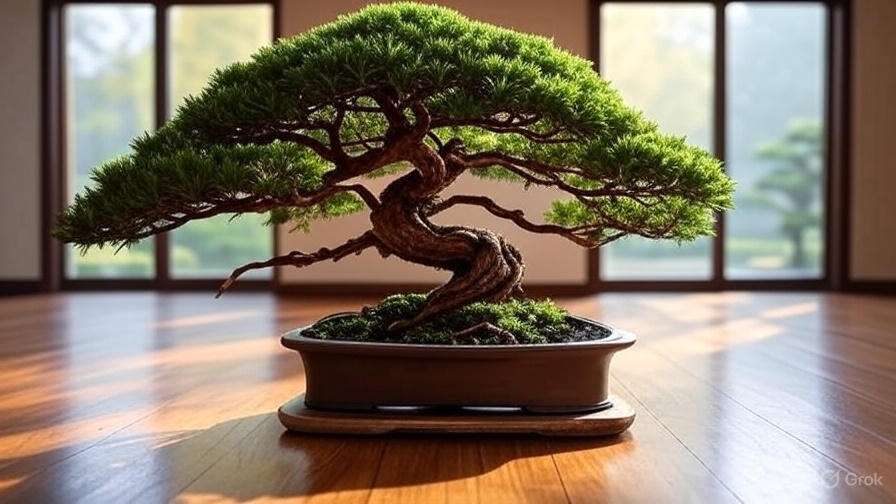
So, why wait? Begin your juniper bonsai journey today with the confidence that you have all the tools and tips to help your bonsai flourish. Happy gardening!
Frequently Asked Questions(FAQ)
How often should I water my juniper bonsai tree?
Juniper bonsai trees prefer deep watering, but they do not like being waterlogged. Water your tree when the top inch of soil feels dry. Ensure the water drains freely from the pot, and avoid letting the tree sit in standing water.
Can juniper bonsai trees grow indoors?
Yes, juniper bonsai trees can be grown indoors, but they need plenty of bright sunlight to thrive. Place your bonsai near a south-facing window or use grow lights to provide at least 6 hours of direct sunlight each day.
What type of soil is best for juniper bonsai trees?
Juniper bonsai trees thrive in well-draining, slightly acidic soil. A mix designed specifically for bonsai, containing akadama, pumice, and lava rock, is ideal as it allows for proper drainage and root aeration.
How do I prune and style my juniper bonsai?
Prune juniper bonsai trees by removing dead or overgrown branches and shaping them to enhance their natural form. Use bonsai wire to gently bend and shape the branches, but be careful not to damage the tree’s bark. Pruning is best done during the growing season, typically in early spring or late summer.
How often should I repot my juniper bonsai tree?
Report your juniper bonsai every 2 to 3 years, depending on its growth rate. This will help refresh the soil, check the root system, and ensure that the tree has enough space for healthy growth. Make sure to prune the roots slightly when repotting to keep them manageable.
What are the common pests that affect juniper bonsai trees?
Common pests that affect juniper bonsai trees include spider mites, aphids, and scale insects. Keep an eye on the leaves and branches for signs of infestation, such as discolored or damaged foliage. Treat with insecticidal soap or neem oil to keep pests under control.
How do I protect my juniper bonsai from winter frost?
In colder climates, protect your juniper bonsai from frost by moving it indoors during the winter or placing it in a sheltered spot, such as a greenhouse or cold frame. If kept outdoors, ensure the pot is well-drained, and consider wrapping it with insulation to prevent root damage.
How long does it take for a juniper bonsai tree to grow?
Juniper bonsai trees grow relatively slowly, with noticeable changes in shape and size taking 2 to 3 years, depending on care and growing conditions. Be patient, as bonsai trees take time to develop into their full potential, but consistent care will reward you with a beautiful, mature tree.








